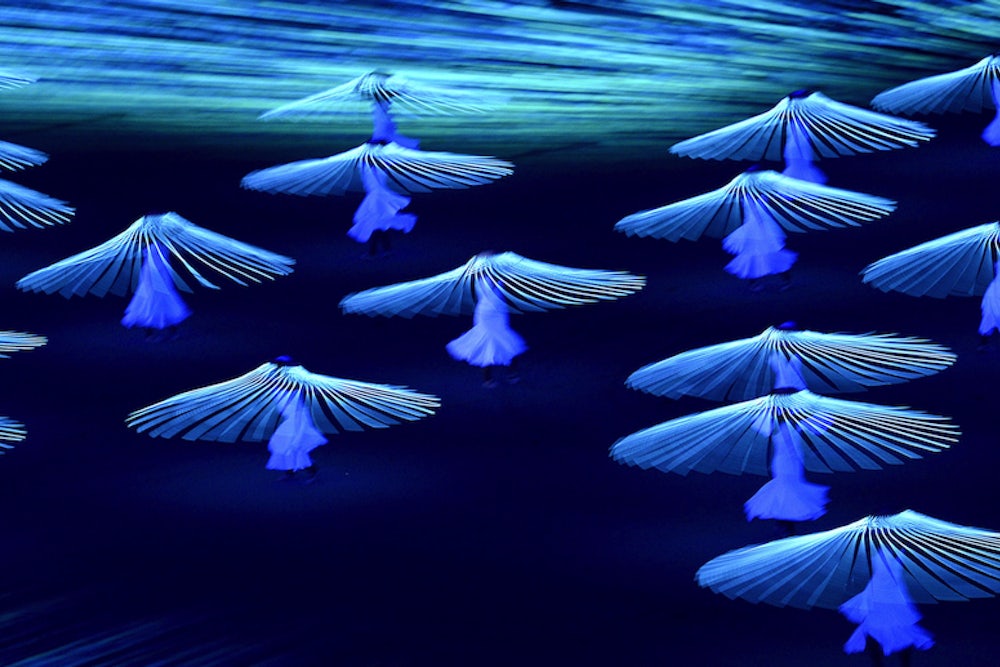Perhaps the tide is turning. Little did I know that I was spending the day writing a piece for this publication taking the press to task for being so ungracious toward their Olympic host, that The New Republic was running a piece by Julia Ioffe arguing the same thing. So perhaps we’re leading a pendulum swing in the other direction.
I, for one, want Sochi to work. I’m tired of the “nice, but” variety of headlines (e.g. “Russia shows culture and strength, but unease remains”). Okay, we get it. Russia’s not Holland. Putin’s not Helle Thorning-Schmidt. But right now it just wants to be a good host and see everyone have a good time and not get blown up.
So far, so good. At the opening ceremony, there were no casualties that I know of. The proceedings were admittedly very long, three hours, but that’s speaking as someone who had to watch them. For a viewer at home, hanging out over beers with friends, they would have been great. There was a sequence of a girl with a kite flying over all Russia as different regions drifted by on what looked like giant floats amid fog. There were athletic figures depicted with flickering stars. There was the march of Venezuela’s sole athlete at the games, 43-year-old alpine skier and cancer survivor Antonio Pardo. Only a heart of ice could fail to appreciate such things.
By the way, Pardo was part of the traditional parade of athletes, which can grow a bit tiresome for home viewers, especially with 88 countries to get out of the way. But that moment is, understandably, what many athletes treasure most in their experience of the games, so it’s worth taking a moment to appreciate what the Sochi designers came up with to enhance the scene. For one thing, they engineered a lot of fancy lighting tricks. More important, each cadre of athletes led by a “snow maiden,” or snegurochka—a Russian model who wears an all-white ensemble consisting of knee-high boots, a miniskirt, a crest-shaped kokoshnik snowflake headdress, and a pair of large torso-encircling translucent rings that display the name of a country. I like snegurochkas very much and hope to see more of them. Also, their outfits are perfect for The Hunger Games, which is probably Putin’s next project.
What followed the parade were massive changing sets and the music of Tchaikovsky and Stravinsky and dance sequences taking us through all of Russian history. Viewers undoubtedly wondered how choreographers would handle the unhappy parts of Russian history—i.e. Russian history. But the different eras got represented with taste and even integrity. The Russian revolution got depicted in the form of trains and hammers and sickles, and the Stalin years got depicted in terms of the Spartan aesthetics of the age. It worked. Really. You try telling a feel-good story about Russia.
The speeches, which I confess I didn’t listen to, were good. That is, I liked the part that I read in reports—including the line from Sochi Olympic Organizing Committee President Dmitry Chernyshenko about “when we come together in all our diversity, it is the Olympic Games that unite us.” Banal as that is, it’s true, and it’s why the games are beautiful.
But I’d say it’s not just the “games” that bring us together. It’s a devotion to civilization itself, and that’s clearer when you start to hear from the opposing side, with representatives like Chechen rebel leader Doku Umarov, who has vowed to disrupt the games any way possible. Call Russia on its many sins if you want, but what united everyone laboring under that dome was a commitment to making something beautiful, to having people say “ah!” in pleasure and wonderment—to doing all of the things that humans do to reach for something fleeting but sublime. And buttheads like Doku Umarov want to blow it up.
So, yeah, I want the games to go wonderfully. I hope members of the media get doors and non-dangerous water in their rooms at some point during their stay. I hope Vladimir Putin hang glides shirtless into the stadium at some point, just to mix things up a bit. And I also look forward to less churlish coverage of the games. Case in point: no harping on the fifth ring. In case you missed it, the mishap that lit up Twitter was a failure during the opening ceremony of one of five large projected snowflakes to morph into a fifth large Olympic ring. The snafu was symbolic, said some. Only if you choose to believe so. I don’t.
